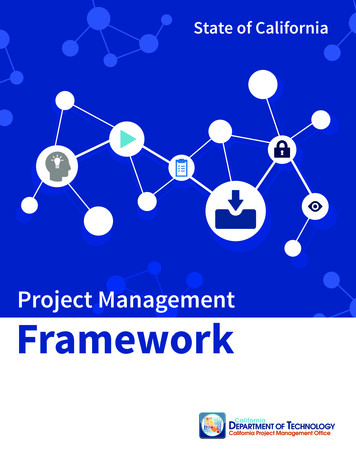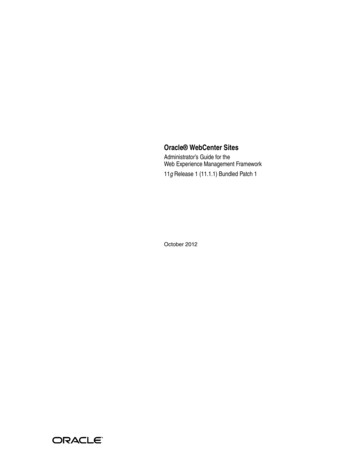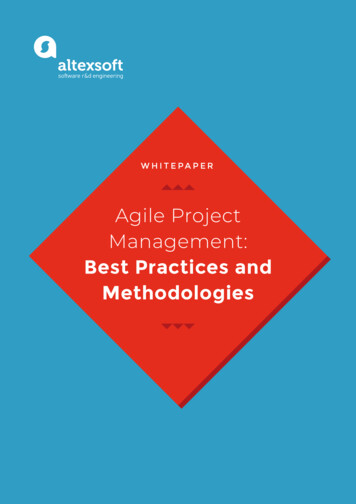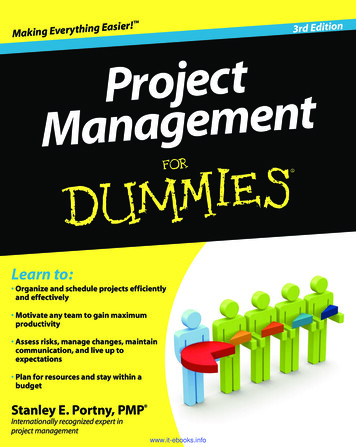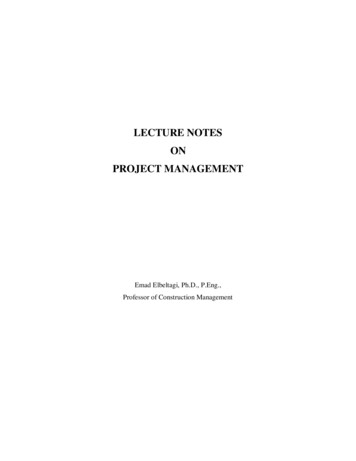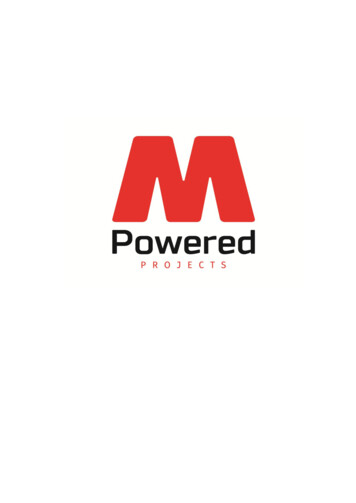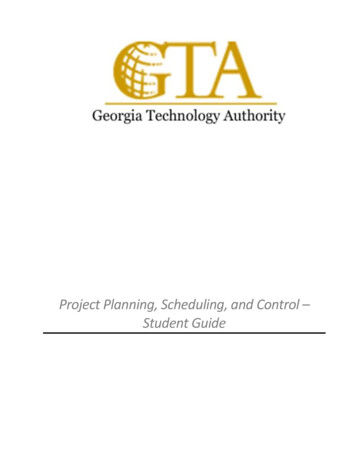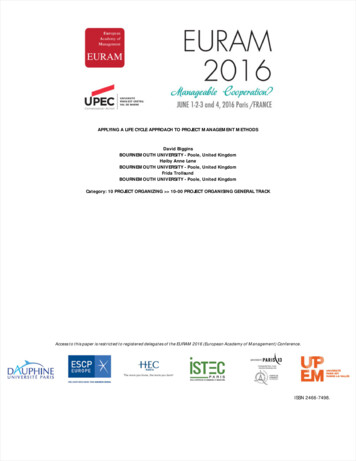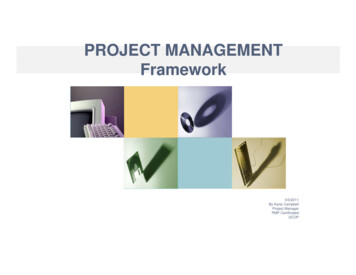
Transcription
PROJECT MANAGEMENTFramework3/3/2011By Karla CampbellProject ManagerPMP CertificatedUCOP
Topics1. Benefits Of Project Management2 Definitions2.3. Roles4. Project Process Groups5. Best Practices6. Tools and Services7 Appendix (Templates)7.2
1. Benefits of Project Management WhWhatt are ththe bbenefitsfit tot ProjectP j t Management?Mt?– Ability to balance competing demands– Clear and understood pprojectjscopep and pproblemstatement– Identification of project risks with documentedstrategies– Consistent method for monitoring andcontrolling project deliverables andmilestones– Improved communication amongproject team, executive sponsor, leadership andstakeholders– Ability to measure project performance– Early Identification of potential problems– UnderstandingU d t di off iimpactt tto titimelineli andd criticaliti lpath when deliverables are changed3
2. Definitions Whatt iis a PWhProject?j t?– A Project is a temporary endeavor undertaken to create a uniqueproduct or service.What is ProjectjManagement?g– Is the process of using proven tools and techniques to manage thescope, time and cost of a project.ValueScopeAny change to one will effect the othersAll sides are equal4
2. Definitions Baseline– Original approved Project Scope, timeline and cost, a placeGantt Chart– Graphic display of activities in the schedule represented by bars chartsIssue– Topic or point that is in question or dispute, a matter that is not settled orclear. Best Practices are to state it as a question (see Appendix for template)Milestone– A significant activity or event in the projectScope– Apparagraphg p describingg the characteristics of a pprojectjand sum of theproduct or services. If a date is a driver or budget is a driver put this in thescope definition– It is equally important to have a paragraph or bullets on what is out scope,this may be difficult in the beginning of the project but as the projectdevelops this will become more clearSME (Subject Matter Expert)– Is a person who exhibits the highest level of expertise in performing aspecialized jobjob, tasktask, or skill within an organization– Functional teams are usually formed through subject matter expertise5
2. Definitions Stakeholders– Person or organization (e.g., customer, sponsor, another organization, orthe public) that is actively involved in the project, or whose interests may bepositively or negatively affected by execution or completion of the project. Astakeholder may also exert influence over the project and its deliverablesRi kRisk– An event or condition that may occur and it may have a positive or negativeimpact on the project. How to determine Priorityy (see Appendix for template)– Impact – what is the impact if this risk was to occur– Probability – what is the likelihood this risk will occurRisk Strategies– Mitigation - reduce impact and if possible probability– Avoidance- avoiding or eliminating the cause– Transference – shifts impact and transfer risk to a third party– Acceptance - no plans - willing to accept consequencesWBS– Work Breakdown Structure – Hierarchical representation of deliverables;each level represents more detail and definition. Great tool in planning orlaying out the project schedule; and can assist in identify stakeholders (seeAppendix for template)6
3. Roles What are all the roles yyou will need on a projectp jteam?– Executive Steering Committee Provides a stabilizing influence so organizational concepts anddirections are established and maintained with a visionary view;provides insight on long-term strategies in support of legislativemandates; ensure business objectives are being adequately addressedand the project remains under control– Executive Sponsor Provides the official backing, resources , strategic direction andapprovalppof the pproject.jHelpsp pprojectjowner navigategthroughg ppoliticalenvironment and monitors political environment to help project adjust;owns the final product; signs off on charter and scope objectives– Project Owner Overall responsibility for project implementation:– Keeps the project on track byb meeting withith project manager on aconsistent basis; provides and locates resources for the project andresolves any resource allocation issues; when roadblocks occur forteam - prevent scope and schedule creep; decision maker on day today activities; escalates issues or concerns to the executive sponsor;ensures executive sponsor is briefed on status of project– Responsibility of the planning and execution of any project to meet theproject objectives; Prepares project documentations for input and signoff; Tracks and monitors project progress; Escalate issues and risks toand from the core project team to Executive Sponsor for decisions;Responsible for the proper closing of a project; Maintains an objectivepoint of view through out the project7
4. Process Groups Project Management Process utingClosing8
4. Process Groups INITIATING– Recognizing that a project is worth doing– Determining what the project shouldaccomplish– Defining the overall project goal– Defining general expectations of customers,management or other stakeholdersmanagement,– Defining the general project scope and problemstatement– Selecting initial members of the project team– Deliverable Project Charter9
4. Process Groups PLANNING– Refining the project scope– Listing tasks and activities– Sequencingqg activities– Developing a workable schedule andbudgetg– Assigning resources to the activities– Gettingg the pplan approvedpp“baseline”– Deliverable Project Management Plan10
4. Process Groups EXECUTION––––Leading the teamM ti withMeetingith tteam membersbCommunicating with stakeholdersResolving conflicts that always arise during aProject– Approveppchangeg requestq– Securing necessary resources (money,people, equipment) to carry out the projectplan– Deliverable RFQ/RFP or Distribution of theschedule issues and risks on a weekly basisschedule,11
4. Process Groups MONITORING and CONTROLLING–––––––Monitoring deviations in budget or scheduleTaking corrective actionEvaluating potential impacts of projectInitiating change request processRescheduling the project activitiesAdapting resource levelsAdjusting project goals (as long as you haverevisited planning)– Getting changes approved by stakeholders– Updating project documentation– DeliverableD libl ProgressPreportingti12
4. Process Groups CLOSING– Validating the last of the tasks arecompletel t ini ththe projectj t planl– Releasing resources– Lessons learned– Final vendor payment– Writing a final project report– Sponsor sign off– Closing out the files– Deliverable Transition or turnover plan toproduction support;ppp ; a Lesson Learneddocument13
5. Best Practices1ComponentCommentsInitiating Sponsor/Owner of product or service Project Charter/Business NeedProblem Statement should be included in theProject CharterPlanning Kick Off Meeting Stakeholders identified Core Project Team IdentifiedYou may have several Kick Off Meetings; Senior Management; Executive Steering Core Project Team StakeholdersPlanning Project Scope; includes out of scope Success Criteria Assumptions Constraints Requirements Roles and Responsibilities Communication Plan Timeline IssuesI Risks Cost/BudgetDocuments Project Scope If the project does not have aproject chartercharter, problem statementmust be included in the projectscopeExecution Team Meetings Change Request form Updating Issues, Risk Managing RFQ/RFPMonitoringControllingClosing Progress Reports Executive Summary Reconciling back to scope and problem statement Contracts Closed Turnover documents completed Lessons Learned meetings Team CelebrationsImportant to celebrate successes throughout theproject as well as tracking lessons learned!1416
6. Tools and ServicesMicrosoft Word Excel Visio PowerPoint ProjectChecklist Project Checklist(see page 14) Templates(see Appendix)ProjectjAssistance Karla Campbell(karla.campbell@ucop edu)op.edu)510-987-0707 ProjectManagementInstitute(PMI)pmi.org15
7. Appendix – WS SHIP Project Structurei SteeringSi Committee:CiAdvisoryAdiGGroup EExecutive Lead Ld StaffS ff(COC, COVC, COVCA, Brostrom, Gottfredson, Plotts, (Reese, Crowder,Taylor, & WhiteCUCSA, ITLC, etc.)Baird) EExecutivei Sponsor:SNathan BrostromCampuses Project Owner:UCOPMik BaptistaMikeB ti t &Heather Pineda StakeholdersFunctional Team:M i Blandizzi,MariaBl di i CharlieCh liRegentsMcDonough, Alan Moloney,LABSKarla Campbell, et. al. CCampusMManagers (i(informal):fl)To be determined by ProjectOwner & his/her FunctionalTeamState of CAMedical Ctr.16
7. Appendix – WS SHIP Project Structure Roles and ResponsibilitiesResource FullNameTitleAreaNathan BrostromEVP, BusinessOperations, UCOPBusinessOperationBusinessPhoneNumber(510) 9879029Business EmailProject RoleResponsibilitiesMike BaptistaExecutive Director,UCOPHumanResources(510) 9879383Michael.Baptista@ucop.eduProject OwnerDirection, support,arbitration,Heather PinedaDirector, UCOPHumanResources(510) 9879232Heather.Pineda@ Project Ownerucop.eduDirection, support,arbitration,Karla CampbellProject ManagerOffice ofStrategicChangeResource(510) 9870707Karla.Campbell@ Functional Team,ucop.eduProject ManagerSubject Matter Expertin ProjectManagementM i BlMariaBlandizzidi iDirector, SDiSpeciali lProjects, UCSFStudentSdAcademicAffairs((510)10) 989879551Maria.blandizzi@Mi bl di i@ FFunctionalilTTeam,ucsf.eduCoordination ofWorkgroupManage projectMjplan,lmonitor, documentAlan MoloneyDirector, UCOPPurchasingandContracts(510) 9870824Alan.moloney@upcop.eduFunctional Team,ProcurementConsultant and Leadon RFPCharlesMcDonoughManager, StudentHealth andCounseling, UCSFStudentHealth andCounseling(415) 4761584charles.mcdonough@ucsf.eduFunctional Team,Coordination ofWorkgroupNathan.brostrom@ucop.eduExecutive SponsorDecision maker;provides direction,guidance.Manage the RFPprocess;; a lead inpnegotiations ofvendors utilizing theconsultants.Subject Matter Expert,Project Coordination17
7. Appendix – Problem StatementProblem Statement Template:The problem of (description) affects (list stakeholders affected). The impact ofwhich is (describe the impact of the problem).problem) A successful solution would (list somekey benefits of a successful solution).P blProblemStatementSt tt ExampleEl (provided by Rational Unified Process (RUP)):The problem of untimely and improper resolution of customer service issues affectspp reps,p , and service technicians the impactpoff whichour customers,, customer supportis customer dissatisfaction, perceived lack of quality, unhappy employees and loss ofrevenue. A successful solution would provide real‐time access to a troubleshootingdatabase by support reps and facilitate the timely dispatch of service technicians toonly those locations that genuinely need their assistanceassistance.18
7. Appendix - WBS Also, having a description of each box is helpful to fully understand what thedeliverable is trying to achieve.19
7. Appendix - Schedule20
7. Appendix - Schedule21
7. Appendix – Issues ListKey# - unique numberStatus - Indicator - (red) will cause delays, (yellow) - may cause delays -(green) - on target,Priority - Urgent cannot continue if not resolved; High must be resolved; Medium must beresolve can have business "work around"; Low does not need to be resolved by project deliveryRegarding - One or two words categorizing the item - staffing, communications, Labor, budget- be consistentDate Opened - list the date mm/dd/yyyy item was openedDescription - Issue should be stated with a question,Actions Plans - latest plan to resolve this issue, best to start with a date to separate notesAssigned to - Responsible to get resolution and is accountable for this issue (coordinatediscussions, escalate if help is needed.Target Close Date - Date in which items is targeted to be ntractDateOpenedDescriptionD fi i i off an IssueDefinitionIA point or matter in question or in dispute, or a point or matterthat is not settled and is under discussion or over which thereare opposing views or disagreements.(PMBOK Guide – Third Edition – 2006)Sort By:Action lansAssigned to2/28 - Make your notes brief but enough to understand what isgoing on and how this issue is being resolve; 2/23 - Purpose ofan issues list is for tracking and knowing who is working on whatissue. Also to have a record of how an issues was resolved.Alan10/8/20102/28 - Make your notes brief but enough to understand what isgoing on and how this issue is being resolve; 2/23 - Purpose ofan issues list is for tracking and knowing who is working on whatissue. Also to have a record of how an issues was resolved.Maria, Alan10/22/20102/28 - Make your notes brief but enough to understand what isgoing on and how this issue is being resolve; 2/23 - Purpose ofan issues list is for tracking and knowing who is working on whatissue. Also to have a record of how an issues was resolved.Heather9/30/2010M k your notes briefb i f butb enoughh to understanddd whath iis2/28 - Makegoing on and how this issue is being resolve; 2/23 - Purpose ofan issues list is for tracking and knowing who is working on whatissue. Also to have a record of how an issues was resolved.Karla10/8/2010What is the purpose of an issues List22
7. Appendix - Risk ListKeyConsequences - if this risk does occur what are the consequences (positive or negative)Impact, Probability: 1-High, 2-Medium, 3-LowPriority - result form the Look Up table regarding input from Impact and Probability - 1-VeryHigh , 2- High , 3- Medium, 4- Low, 5- Very LowStrategy - Avoidance, Transference, Mitigation, Acceptance Avoidance - avoiding oreliminating the cause; Transference - transfer risk (third party); Mitigation - reduce impact ;Acceptance - no plans - willing to accept consequencesContingency Plan- If possible are there contingency plans that can be executed if the Riskoccurs#Event/Risk DescriptionDateOpened by OpenedConsequencesIf resources are notavailable it will have aResources must be available on this negative impact on1projecttimeline and budget.Definition of a Risk An uncertain event or condition that, if it occurs,has a positive or negative effect on a projectobjectives. (PMBOK Guide – Third Edition – 2006)Impact Probability Priority1-High1-High1 on - workingwith leadership anddepartment directionsto verify resourceavailability; should beresolved by 4/1/11Priority TableImpactProbability Priority1 Hi1Highh1 Hi h1-High1 V1Very HiHighh RiRiskk1- High2- Medium2- High Risk2- Medium2- Medium3- Low1- High2- Medium3- Low3- Low1-High2- Medium1- High3- Low3- Low2- Medium3- Low2- High Risk3- Medium Risk3- Medium Risk3- Medium Risk4- Low Risk4- Low Risk4- Low Risk23
Mar 04, 2011 · Karla Campbell Project Manager Office of Strategic Change Resource (510) 987-0707 Karla.Campbell@ ucop.edu Functional Team, Project Manager Subject Matter Expert in Project Management MiBl di iMaria Blandizzi Di S i lDirector, Special Sd ( 10) 98 M i bl di i@ Fi lTMjl Projects, UCSF Student
